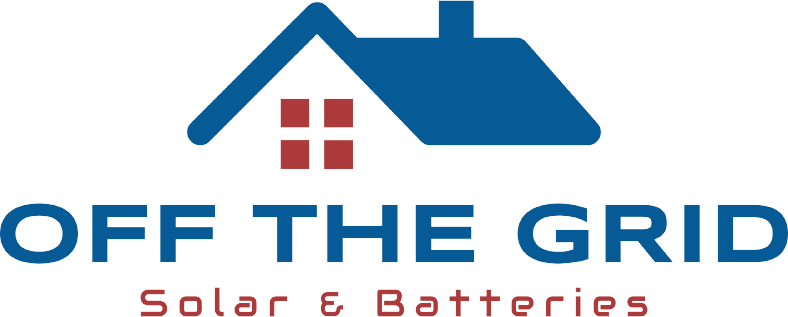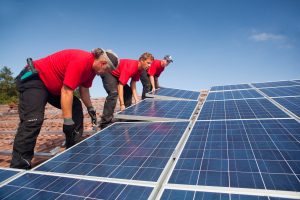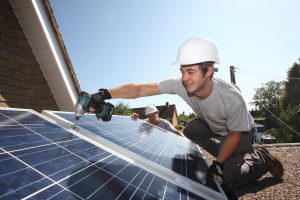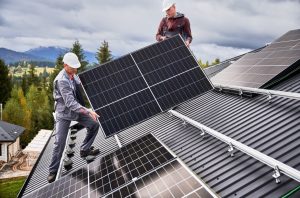[fusion_builder_container hundred_percent=”yes” overflow=”visible”][fusion_builder_row][fusion_builder_column type=”1_2″ last=”no” spacing=”yes” center_content=”no” hide_on_mobile=”no” background_color=”” background_image=”” background_repeat=”no-repeat” background_position=”left top” hover_type=”none” link=”” border_position=”all” border_size=”0px” border_color=”” border_style=”” padding=”” margin_top=”” margin_bottom=”” animation_type=”” animation_direction=”” animation_speed=”0.1″ animation_offset=”” class=”” id=””][fusion_text][fusion_dropcap color=”#000000″ boxed=”no” boxed_radius=”8px” class=”” id=””]W[/fusion_dropcap]e can change sunlight directly to electricity using solar cells. Every day, light hits your roof’s solar panels with photons (particles of sunlight). The solar panel converts those photons into electrons of direct current (“DC”) electricity. The electrons flow out of the solar panel and into an inverter and other electrical safety devices. The inverter converts that “DC” power (commonly used in batteries) into alternating current or “AC” power. AC power is the kind of electrical that your television, computer, and toasters use when plugged into the wall outlet.[/fusion_text][fusion_text][fusion_dropcap color=”#000000″ boxed=”no” boxed_radius=”8px” class=”” id=””]A[/fusion_dropcap] net energy meter keeps track of the all the power your solar system produces. Any solar energy that you do not use simultaneous with production will go back into the electrical grid through the meter. At night or on cloudy days, when your system is not producing more than your building needs, you will consume electricity from the grid as normal. Your utility will bill you for the “net” consumption for any given billing period and provide you with a dollar credit for any excess during a given period. You can carry your bill credit forward for up to a year.[/fusion_text][/fusion_builder_column][fusion_builder_column type=”1_2″ last=”yes” spacing=”yes” center_content=”no” hide_on_mobile=”no” background_color=”” background_image=”” background_repeat=”no-repeat” background_position=”left top” hover_type=”none” link=”” border_position=”all” border_size=”0px” border_color=”” border_style=”” padding=”” margin_top=”” margin_bottom=”” animation_type=”” animation_direction=”” animation_speed=”0.1″ animation_offset=”” class=”” id=””][fusion_separator style_type=”none” top_margin=”30px” bottom_margin=”” sep_color=”” border_size=”” icon=”” icon_circle=”” icon_circle_color=”” width=”” alignment=”center” class=”” id=””/][fusion_imageframe lightbox=”no” gallery_id=”” lightbox_image=”” style_type=”none” hover_type=”none” bordercolor=”” bordersize=”0px” borderradius=”0″ stylecolor=”” align=”left” link=”” linktarget=”_self” animation_type=”0″ animation_direction=”down” animation_speed=”0.1″ animation_offset=”” hide_on_mobile=”no” class=”” id=””] 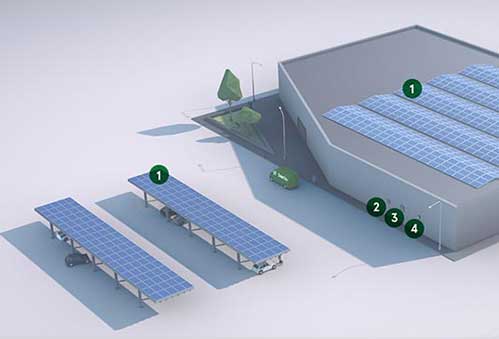 [/fusion_imageframe][/fusion_builder_column][fusion_builder_column type=”1_2″ last=”no” spacing=”yes” center_content=”no” hide_on_mobile=”no” background_color=”” background_image=”” background_repeat=”no-repeat” background_position=”left top” hover_type=”none” link=”” border_position=”all” border_size=”0px” border_color=”” border_style=”” padding=”” margin_top=”” margin_bottom=”” animation_type=”” animation_direction=”” animation_speed=”0.1″ animation_offset=”” class=”” id=””][fusion_separator style_type=”none” top_margin=”20px” bottom_margin=”” sep_color=”” border_size=”” icon=”” icon_circle=”” icon_circle_color=”” width=”” alignment=”center” class=”” id=””/][fusion_youtube id=”ORni8uiuslI” width=”600″ height=”500″ autoplay=”no” api_params=”” class=””/][/fusion_builder_column][fusion_builder_column type=”1_2″ last=”yes” spacing=”yes” center_content=”no” hide_on_mobile=”no” background_color=”” background_image=”” background_repeat=”no-repeat” background_position=”left top” hover_type=”none” link=”” border_position=”all” border_size=”0px” border_color=”” border_style=”” padding=”” margin_top=”” margin_bottom=”” animation_type=”” animation_direction=”” animation_speed=”0.1″ animation_offset=”” class=”” id=””][fusion_text]
[/fusion_imageframe][/fusion_builder_column][fusion_builder_column type=”1_2″ last=”no” spacing=”yes” center_content=”no” hide_on_mobile=”no” background_color=”” background_image=”” background_repeat=”no-repeat” background_position=”left top” hover_type=”none” link=”” border_position=”all” border_size=”0px” border_color=”” border_style=”” padding=”” margin_top=”” margin_bottom=”” animation_type=”” animation_direction=”” animation_speed=”0.1″ animation_offset=”” class=”” id=””][fusion_separator style_type=”none” top_margin=”20px” bottom_margin=”” sep_color=”” border_size=”” icon=”” icon_circle=”” icon_circle_color=”” width=”” alignment=”center” class=”” id=””/][fusion_youtube id=”ORni8uiuslI” width=”600″ height=”500″ autoplay=”no” api_params=”” class=””/][/fusion_builder_column][fusion_builder_column type=”1_2″ last=”yes” spacing=”yes” center_content=”no” hide_on_mobile=”no” background_color=”” background_image=”” background_repeat=”no-repeat” background_position=”left top” hover_type=”none” link=”” border_position=”all” border_size=”0px” border_color=”” border_style=”” padding=”” margin_top=”” margin_bottom=”” animation_type=”” animation_direction=”” animation_speed=”0.1″ animation_offset=”” class=”” id=””][fusion_text]
Solar Cells
Solar cells are small, square-shaped panel semiconductors made from silicon and other conductive materials, manufactured in thin film layers. When sunlight strikes a solar cell, chemical reactions release electrons, generating electric current. Solar cells are also called photovoltaic cells or “PV cells” and can be found on many small appliances such as calculators.
Click edit button to change this text.[/fusion_text][fusion_text]
Solar Photovoltaic (PV) System Components
A PV system components include PV modules (groups of PV cells), which are commonly called PV panels; one or more batteries; a charge regulator or controller for a stand-alone system; an inverter to covert solar power from direct current (DC) to the alternating current (AC) of the utility grid-connected system; wiring; and mounting hardware or a framework. A PV module arranges individual PV cells, and the modules are grouped together in an array. Some of the arrays are set on special tracking devices to follow sunlight all day long and improve system efficiency.[/fusion_text][/fusion_builder_column][fusion_builder_column type=”1_1″ background_position=”left top” background_color=”” border_size=”” border_color=”” border_style=”solid” spacing=”yes” background_image=”” background_repeat=”no-repeat” padding=”” margin_top=”0px” margin_bottom=”0px” class=”” id=”” animation_type=”” animation_speed=”0.3″ animation_direction=”left” hide_on_mobile=”no” center_content=”no” min_height=”none”][fusion_title size=”2″ content_align=”left” style_type=”underline dashed” sep_color=”” margin_top=”” margin_bottom=”” class=”” id=””]PV System Installation, Maintenance, and Longevity[/fusion_title][fusion_text]You could install a photovoltaic (PV) or solar electric system yourself. But to avoid complications or injury, you will probably want to hire a reputable professional contractor with experience installing solar systems. While they are sophisticated electric systems, PV systems have few moving parts, so they require little maintenance. The basic PV module (an interconnected, enclosed panel of PV cells) has no moving parts and can last more than 30 years while requiring little maintenance. The components are designed to meet strict dependability and durability standards to withstand the elements. The best way to ensure and extend the life and effectiveness of your PV system is by having it installed and maintained properly.[/fusion_text][/fusion_builder_column][fusion_builder_column type=”1_1″ background_position=”left top” background_color=”” border_size=”” border_color=”” border_style=”solid” spacing=”yes” background_image=”” background_repeat=”no-repeat” padding=”” margin_top=”0px” margin_bottom=”0px” class=”” id=”” animation_type=”” animation_speed=”0.3″ animation_direction=”left” hide_on_mobile=”no” center_content=”no” min_height=”none”][fusion_title size=”2″ content_align=”left” style_type=”underline dashed” sep_color=”” margin_top=”” margin_bottom=”” class=”” id=””]Incorporating PV Systems into Your Home and Business[/fusion_title][fusion_text]PV systems today can be blended easily into both traditional and nontraditional homes, powering appliances and electric systems. PV cells can be installed as a stand-alone module that is attached to your roof or on a separate system, or using integrated roofing materials with dual functions – that as a regular roofing shingle and as a solar cell making electricity. The most common practice is to mount modules onto a south-facing roof or wall. PV systems likewise can be blended into virtually every conceivable structure for commercial buildings. You will find PV used outdoors for security lighting as well as in structures that serve as covers for parking lots and bus shelters.[/fusion_text][/fusion_builder_column][/fusion_builder_row][/fusion_builder_container]
